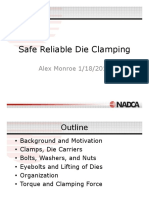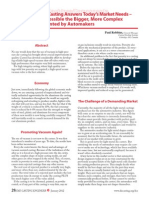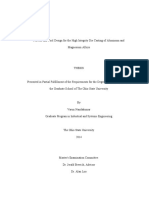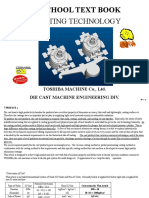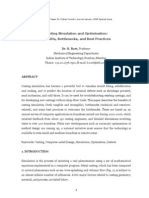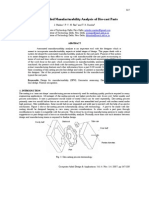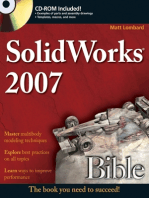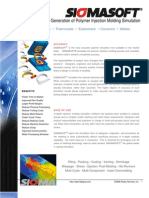0 ratings0% found this document useful (0 votes)
154 views001 Plunger PDF
001 Plunger PDF
Uploaded by
Kmilo Giraldo1) The interaction between the plunger tip and shot sleeve is critical in die casting as it must maintain a small gap (less than 0.004 inches) while delivering molten metal without interference or excess lubrication.
2) Controlling the temperature of the plunger tip is important to maintain the proper gap, as temperature increases can cause the tip to expand beyond the critical size. New plunger tip designs use materials with coefficients of expansion that make temperature control easier.
3) The ARP plunger tip was developed to improve heat transfer from the tip for better temperature control through its internal water cooling design, while a new high-strength AMP tip was created to handle larger parts and faster production speeds.
Copyright:
© All Rights Reserved
Available Formats
Download as PDF, TXT or read online from Scribd
001 Plunger PDF
001 Plunger PDF
Uploaded by
Kmilo Giraldo0 ratings0% found this document useful (0 votes)
154 views4 pages1) The interaction between the plunger tip and shot sleeve is critical in die casting as it must maintain a small gap (less than 0.004 inches) while delivering molten metal without interference or excess lubrication.
2) Controlling the temperature of the plunger tip is important to maintain the proper gap, as temperature increases can cause the tip to expand beyond the critical size. New plunger tip designs use materials with coefficients of expansion that make temperature control easier.
3) The ARP plunger tip was developed to improve heat transfer from the tip for better temperature control through its internal water cooling design, while a new high-strength AMP tip was created to handle larger parts and faster production speeds.
Original Title
001_PLUNGER.pdf
Copyright
© © All Rights Reserved
Available Formats
PDF, TXT or read online from Scribd
Share this document
Did you find this document useful?
Is this content inappropriate?
1) The interaction between the plunger tip and shot sleeve is critical in die casting as it must maintain a small gap (less than 0.004 inches) while delivering molten metal without interference or excess lubrication.
2) Controlling the temperature of the plunger tip is important to maintain the proper gap, as temperature increases can cause the tip to expand beyond the critical size. New plunger tip designs use materials with coefficients of expansion that make temperature control easier.
3) The ARP plunger tip was developed to improve heat transfer from the tip for better temperature control through its internal water cooling design, while a new high-strength AMP tip was created to handle larger parts and faster production speeds.
Copyright:
© All Rights Reserved
Available Formats
Download as PDF, TXT or read online from Scribd
Download as pdf or txt
0 ratings0% found this document useful (0 votes)
154 views4 pages001 Plunger PDF
001 Plunger PDF
Uploaded by
Kmilo Giraldo1) The interaction between the plunger tip and shot sleeve is critical in die casting as it must maintain a small gap (less than 0.004 inches) while delivering molten metal without interference or excess lubrication.
2) Controlling the temperature of the plunger tip is important to maintain the proper gap, as temperature increases can cause the tip to expand beyond the critical size. New plunger tip designs use materials with coefficients of expansion that make temperature control easier.
3) The ARP plunger tip was developed to improve heat transfer from the tip for better temperature control through its internal water cooling design, while a new high-strength AMP tip was created to handle larger parts and faster production speeds.
Copyright:
© All Rights Reserved
Available Formats
Download as PDF, TXT or read online from Scribd
Download as pdf or txt
You are on page 1of 4
At a glance
Powered by AI
The document discusses the importance of maintaining a precise gap between the plunger tip and shot sleeve during die casting to avoid defects. It also emphasizes considering all components of the die casting process as an interacting system.
Maintaining a consistent temperature and gap between the plunger tip and shot sleeve is challenging due to thermal expansion. Excessive plunger tip wear can occur if insufficient cooling is provided.
The document states that porosity in die castings can be almost eliminated through an efficient vacuum system, which evacuates air from the mold cavity before injection.
Die Interaction
Better Lubricants/Plunger Tips
— Key to Better Die Casting
Paul Robbins, General Manager
CASTOOL
Uxbridge, Ontario
The Moment of Casting Maintaining the Gap
The plunger, moving smoothly with a minimum of lubrica- The maximum gap between the plunger tip and the shot
tion, pushes a measured amount of molten alloy through sleeve during the casting process is 0.004˝. If at any time
a round and straight shot sleeve and injects it into the die during the shot the gap exceeds that, the alloy is likely
cavity, where it almost instantly hardens. In that moment to penetrate the space, and flash or blowby will occur.
when the liquid alloy is converted into a solid casting, most This will inevitably cause excessive wear on both plunger
of the added value — the die caster’s livelihood — is gen- and sleeve.
erated. This is the crux of the die casting process and may It is essential, therefore, that a gap of less than 0.004˝ be
be fairly termed, “The moment of casting.” maintained at all times during the casting cycle. If the gap
At one time, in the quest for increased productivity, becomes much less than that, there is a danger of interfer-
the component of the die casting process that had the ence and inconsistent shot velocity. Scrap will result. The
greatest potential for improvement was the die itself. Not problem is that when metal is heated, it expands. The im-
all die casters realize that in recent years, this priority portance of controlling the temperature of both plunger tip
has changed considerably. With the use of 3-D com- and shot sleeve is shown by the fact that if the temperature
puter modeling to predict the ideal flow of metal into of a 6-in. copper tip is allowed to rise by 200°F, the diam-
the die and ultra-accurate multi-axis CNC machining eter will increase by more than 0.011˝.
to produce a die that can consistently make large con- Shot sleeves are getting bigger, but whatever the size of
voluted castings with inordinately close tolerances, the the sleeve, that critical maximum gap of 0.004˝ unfortu-
die caster should now be able to assume that the dies nately remains unchanged.
being used are likely as good as they need to be. The best
opportunity for improvement, therefore, now usually lies
with the delivery of the alloy into the die. Analyzing the Controlling the
various forces that impact on the moment of casting, the
die caster of today will soon realize that to even approach
Plunger Tip Temperature
maximum productivity, the plunger and the shot sleeve Plunger tips were originally made of steel, primarily for
must work closely together, since their functions are its durability and economy. A steel tip, of course, has the
inseparably combined. same coefficient of thermal expansion as the shot sleeve
in which it slides. Since the plunger tip is exposed to
more heat than the sleeve, the expansion of a steel tip
is difficult to control very precisely. The next step in the
A Critical Interaction development of the conventional plunger tip was to make
The danger of exceeding a maximum allowable gap it of beryllium copper, which has a coefficient of thermal
between the plunger tip and the shot sleeve has been expansion more than 50% greater than that of steel. This
understood by die casters for many years. The technol- made the expansion of the tip much easier to control. It
ogy of both plunger tips and shot sleeves has improved was then possible to maintain the thermal, and there-
appreciably in the interim. The parameters of the gap, fore the dimensional, stability of the tip throughout the
however, remain unchanged. The interaction between length of the stroke.
the plunger tip and the shot sleeve is certainly the most Die casters usually reduce the temperature of their plung-
critical in the die casting process. It can only be most er tips with water. Excessive plunger tip expansion and wear
effective, however, if both components are operating at is nearly always simply the result of insufficient coolant.
an equal level of efficiency. Even experienced die casters sometimes neglect this.
Also, an effective vacuum can only be achieved if the Rate of flow is easily measured and should be monitored
seal between plunger and shot sleeve remains intact at all constantly. Maintaining an adequate flow of water is vital to
times. If the seal is broken, an effective vacuum is obvi- controlling plunger tip expansion.
ously impossible. The challenge is to maintain a minimal There are some proprietary cooling-intensive plunger tips
gap without interference, while using the least amount that utilize the cooling water much more effectively than
of lubrication. conventional tips.
40/DIE CASTING ENGINEER 1July 2007 www.diecasting.org/dce
The Evolution of a Plunger Tip An additional advantage is that the face of the ARP
is considerably cooler than that of other plunger tips.
This cools the biscuit much faster and reduces the cycle
time significantly.
This does not compromise compression, because since the
wear ring remains relatively hot, while the face of the tip is
much cooler, the outside of the biscuit tends to remain liq-
uid slightly longer, allowing better than usual compression.
Die casters commonly attempt to reduce cycle time by
cooling the die end of the shot sleeve. This unfortunately
tends to shrink the sleeve at the point where the plunger tip
is hottest and is likely at its greatest diameter.
A New High-Strength Plunger Tip
Figure 1 – The ARP Plunger Tip
The ARP plunger tip has been successfully and profitably
The plunger tip in Figure 1 was developed a number of used for a number of years, but the market for aluminum
years ago by Allper of Switzerland. It has evolved over castings is changing. Castings are required, especially in
time in response to changing market demands, without the automotive sector, to be larger, more complex and to
compromising its original mandate of performing its func- have closer tolerances than ever before. They also require a
tion most effectively at the least cost to the die caster. faster rate of production than previously thought possible.
The body of the plunger tip is of beryllium copper for its Plunger tips used to seldom be larger than 6˝. Now, 8˝ tips
high coefficient of thermal expansion. A conventional and even larger are common.
plunger tip screws directly onto the hollow plunger rod. The demands on the plunger tip, particularly in strength
With the ARP, a stainless steel tip holder is screwed onto and stability, outgrew the replaceable wear ring plunger.
the shot rod, and the copper tip is securely fastened to it This led to the development of the Allper high-strength
with a quick release bayonet type connector. The front of AMP plunger tip.
the steel holder lies in full contact with the inside face of This high-strength modular plunger tip was designed
the plunger tip and absorbs the total pressure of the shot. specifically for the production of large castings. The beryl-
The face can then be very thin for better heat exchange. lium copper body is longer, and features a replaceable high-
The water flow is from the center of the shot rod, strength steel head.
through the stainless holder, and directly to the inside face
of the plunger tip where a turbulent flow is generated to
maximize the heat transfer. It then goes through four chan-
nels to the circular external coolant return passage.
Beryllium copper is an ideal medium to dissipate heat
from the plunger to the cooling water. It is, of course, not
nearly as wear-resistant as the steel of the shot sleeve. Since
the tip was then dimensionally stable and the gap control-
lable, this problem was resolved with the development of
a steel wear ring. This tempered steel ring rests freely in a
groove machined near the front of the plunger tip. It is split
and expands against the inside wall of the shot sleeve. Only
the ring wears — not the copper body. The wear ring is
easily removed or installed with a special hand tool in about
five minutes.
The die end of the shot sleeve is chamfered to compress Figure 2 – High-Strength AMP Tip
the ring and guide it back into the sleeve. Because the ring
is flexible, it makes continuous contact with the inside of The challenge to the Allper R&D engineers was to
the shot sleeve. Flash, which is a major cause of wear, is develop a plunger tip that would remain relatively stable
essentially eliminated. Shot speeds are consistent. Since so as to consistently maintain the required gap with
the expanding wear ring ensures a secure seal between the the shot sleeve, but also be strong enough to withstand
plunger and the shot sleeve, a better vacuum can be drawn. extreme pressures, as well as the impact of a short shot if
As only the long-lasting steel wear ring is replaced the plunger contacts the die. Their aim was to use as little
instead of an entire copper body, the cost of consumables is copper as possible, primarily for the strength of steel and
considerably reduced. also for economy.
With a conventional tip, failure of the body is from wear. As with the ARP, a steel holder screws onto the plunger
Failure of the ARP body is only from thermal and pressure rod. The beryllium copper body with its steel head is simi-
fatigue. Operating life is therefore many times longer. larly connected with a quick-release bayonet fastener.
www.diecasting.org/dce July 2007 1DIE CASTING ENGINEER/ 41
With the AMP, after a considerable period of incre- As well, the alloy being poured into the sleeve is at about
mental redesign and field testing, the heat transfer to the 1300°F, while the annealing temperature of H13, the usual
coolant has become much more effective. The tip is more shot sleeve material, is only 1085°F. If the shot sleeve is not
dimensionally stable, and thermal control is less dependent adequately cooled, it will likely lose some of its hardness.
on the high coefficient of thermal expansion of copper. Wear will then more quickly result from the abrasive action
Cycle times are reduced, as well as the cost of consum- of any alloy that penetrates the gap.
ables. With experience, minimum operating life of wear
rings and tip bodies can now be fairly accurately estimated,
and downtime for replacement scheduled in advance so that Porosity and Vacuum
production runs are never unexpectedly interrupted.
The AMP high-strength plunger tip responds to the In cold chamber die casting of light metals, because of
demands of an increasing and changing market. It makes the turbulence of the alloy as it is forced at a high pres-
better castings. sure into the die cavity and the complex shape of many
casting molds, air and other gases are often trapped in
the metal. This, of course, results in porosity in some
parts of the casting.
Cooling the Shot Sleeve If the casting is to be chromed, painted or powder-coat-
Typically, a shot sleeve may become 200-300°F hotter ed, or if any part of the casting is very thin, any air or gas
at the bottom under the pour hole than at the top in inclusions usually result in rejection. Porosity also affects
front of the hole. If the temperature of the sleeve is the mechanical properties of the product. In structural
much higher at the bottom than at the top, unequal applications, porosity can act as a stress concentrator and,
expansion will cause it to become oval instead of round therefore, create a site where cracks may occur.
and slightly bowed rather than straight. Either of these An additional problem is the fact that porosity in a cast-
conditions will cause premature wear of both tip and ing may not always be immediately apparent. If discovered
sleeve. The extent of ovality and distortion is directly after subsequent processing, customer dissatisfaction can
related to both the diameter and length of the shot be extreme.
sleeve. To avoid too much variance in thermal expan- Porosity in the casting can be almost completely elimi-
sion, the bottom of the shot sleeve should be cooled so nated by an efficient vacuum system.
that the difference in temperature, bottom to top, does
not exceed 100°F.
Nearly all die casters cool their plunger tips. Effectively
controlling shot sleeve temperatures, however, is a more
Vacuum-Assisted Casting
difficult challenge. Before the injection shot occurs, a vacuum is drawn in
both the shot sleeve and the mold cavity. The vacuum is
maintained until the injection cycle is completed. Almost
all of the air is positively and quickly evacuated.
Figure 3 – Water-Cooled Shot Sleeve
The pour end of the shot sleeve is where the temperature
is highest. This is obviously where cooling is most neces-
sary. Accordingly, another method of temperature control
is the pour-end cooling jacket. This effective and economi-
cal device puts shot sleeve cooling where it is needed most,
directly below the pour spout. The cooling jacket can also be
reused when the sleeve is replaced.
If uncontrolled, the vertical temperature variance in the
shot sleeve at the pour end will result in a distortion which
may allow some of the alloy to enter part of the gap be-
tween the plunger and the sleeve. This will cause premature
wear and inconsistent shot velocity.
Figure 4 – A Contemporary Vacuum System
42/DIE CASTING ENGINEER 1July 2007 www.diecasting.org/dce
A good vacuum in the mold cavity enables the alloy to For better die casting, the effectiveness of interacting
flow into blind recesses in complex shapes. It also allows components should never be considered individually, but
the fronts of the molten metal to merge freely without always together. Die casting is, in fact, a process that can
forming shuts. only improve when all parts work together as a system.
Whatever vacuum method is employed, if it works well, The most obvious interaction is between the plunger
improved quality and reduced scrap can be guaranteed. and the shot sleeve, but vacuum is becoming increasingly
The principal benefit of vacuum is to eliminate porosity. essential, and it requires an effective plunger-shot sleeve
Product that is rejected is unusually costly to the die caster. function. All three components are therefore connected and
For example, the value of the machine time that is lost while form part of the overall system.
producing the rejected product can never be recovered. Experience has proved that always considering the
Adding a vacuum system to the operating process ben- casting process to be a unified system, rather than
efits a die caster in several ways. First, it reduces his rate of merely a group of disparate components, virtually assures
rejection. Secondly, by lessening the force required on the increased productivity.
plunger, it increases the life of almost all components of
the DCM. But most importantly, by allowing the die caster =
to produce thinner, stronger and more complex castings, it
makes it possible for him to participate in a fast growing About the Author
market sector which would otherwise be denied.
Paul Robbins, general manager of Castool Tooling Systems,
has been in the light metal die casting industry for nearly 30
For Better Die Casting years. After earning a postgraduate degree from the Schulich
School of Business, he joined his father, a Toronto tool maker
The market for light metal die castings continues to who made high quality die casting molds. Robbins is a recog-
grow. Castings are becoming bigger, more complex and nized authority on light metal die casting. He has had many
better in every way. Technology is keeping pace with articles published in industry magazines and has presented
the changing market, but castings are still made by die numerous technical papers at conferences both in the U.S.
casters, not just by machines, and the die caster’s basic and abroad.
approach to the production process is now more impor-
tant than ever.
www.diecasting.org/dce July 2007 1DIE CASTING ENGINEER/ 43
You might also like
- Die Casting - Stress-Relief-Users-Guide531Document37 pagesDie Casting - Stress-Relief-Users-Guide531NandakumarNo ratings yet
- ESI ProCAST CourseDocument1 pageESI ProCAST CourseBashir AsadNo ratings yet
- Rheocasting Structural Components: Martin Hartlieb, Per Jansson, Jean-Claude Tawil, Stéphane BergeronDocument41 pagesRheocasting Structural Components: Martin Hartlieb, Per Jansson, Jean-Claude Tawil, Stéphane BergeronSoria LugoNo ratings yet
- Web043 Safe Reliable Die ClampingDocument40 pagesWeb043 Safe Reliable Die Clampingsinr100% (1)
- Runners, Gates and Feed System DataDocument23 pagesRunners, Gates and Feed System DataMariver LlorenteNo ratings yet
- NADCA-High Temp DieDocument12 pagesNADCA-High Temp DiejalilemadiNo ratings yet
- ProCAST20091 TutorialsDocument213 pagesProCAST20091 TutorialsKmilo Giraldo100% (1)
- Project For Mba Deepak Desai PDFDocument48 pagesProject For Mba Deepak Desai PDFdeepakdesaia23No ratings yet
- Reducing Die Soldering in Die Casting - NADCADocument33 pagesReducing Die Soldering in Die Casting - NADCAAntonio MagañaNo ratings yet
- VacuumDocument6 pagesVacuum03sri03No ratings yet
- ADSTEFAN Management Presentation - HPDCDocument21 pagesADSTEFAN Management Presentation - HPDCGeovanni Emmanuel Aguilar RangelNo ratings yet
- Introduction in Alloys and Influence of Elements: Alloys and Melting 01 - Alloys - and - Melting - EN - Docx 1/13Document13 pagesIntroduction in Alloys and Influence of Elements: Alloys and Melting 01 - Alloys - and - Melting - EN - Docx 1/13luisA1923No ratings yet
- Web072 Die Casting Modeling CapabilitiesDocument33 pagesWeb072 Die Casting Modeling CapabilitiessinrNo ratings yet
- Catalogo Die Cast DMEDocument24 pagesCatalogo Die Cast DMEkontacNo ratings yet
- Magnesium Die CastingDocument3 pagesMagnesium Die CastingReza ArdhyatamaNo ratings yet
- A Study of Casting Characteristics For Die Cast Aluminum Alloy-Anwar HussainDocument23 pagesA Study of Casting Characteristics For Die Cast Aluminum Alloy-Anwar Hussainoquintero99100% (2)
- Study of Flow and Heat Transfer in High Pressure Die Casting Cooling ChannelDocument10 pagesStudy of Flow and Heat Transfer in High Pressure Die Casting Cooling ChannelSüleymanŞentürkNo ratings yet
- Study of Process Parameters in High Pressure Die CastingDocument9 pagesStudy of Process Parameters in High Pressure Die Castingruben6286No ratings yet
- Technical Info About Die CastingDocument5 pagesTechnical Info About Die CastingSanoj KumarNo ratings yet
- ELECTRIC MOTORS IN Explosion PDFDocument43 pagesELECTRIC MOTORS IN Explosion PDFanisNo ratings yet
- Porosity Formation in AlSi9Cu3 Alloy Castings - The Influence of Iron, Strontium, Sodium, Antimony and BismuthDocument240 pagesPorosity Formation in AlSi9Cu3 Alloy Castings - The Influence of Iron, Strontium, Sodium, Antimony and BismuthSüleymanŞentürkNo ratings yet
- Varun Nandakumar MS ThesisDocument101 pagesVarun Nandakumar MS ThesisSubodh Kumar100% (1)
- Hot Chamber Die Casting MachineDocument3 pagesHot Chamber Die Casting MachineAnand BossNo ratings yet
- Die Casting ProcessDocument35 pagesDie Casting ProcessgarciarodrigoNo ratings yet
- ADSTEFAN Version2018Document1 pageADSTEFAN Version2018Kurumsal.ValNo ratings yet
- Dievar D20140715Document16 pagesDievar D20140715Keattikhun ChaichanaNo ratings yet
- Casting Technology: DC School Text BookDocument22 pagesCasting Technology: DC School Text Bookhasan waqarNo ratings yet
- PQ TOS555 How To Check PQ Amplifier (During Pump Run)Document3 pagesPQ TOS555 How To Check PQ Amplifier (During Pump Run)mike100% (1)
- HPDC Thermal Die CyclingDocument5 pagesHPDC Thermal Die CyclingSimon RisteskiNo ratings yet
- 256412Document68 pages256412tabibkarim100% (1)
- Improving Die Casting Melt QualityDocument12 pagesImproving Die Casting Melt QualityCsaba WalczerNo ratings yet
- Pro CastDocument16 pagesPro CastMuhammad BilalNo ratings yet
- Aluminium Diecasting MaterialDocument2 pagesAluminium Diecasting MaterialzainudinNo ratings yet
- Analysis and Validation of Gravity Die Casting ProcessDocument7 pagesAnalysis and Validation of Gravity Die Casting Processhosseinidokht86100% (1)
- Fast Flow Channel SimulationDocument4 pagesFast Flow Channel Simulationgrg_greNo ratings yet
- ME1107-Casting - All PDFDocument24 pagesME1107-Casting - All PDFRizuanul Arefin EmonNo ratings yet
- IdraDocument39 pagesIdrasobheysaidNo ratings yet
- Microsoft PowerPoint - LECTURE3Document36 pagesMicrosoft PowerPoint - LECTURE3Bassel AlshamiNo ratings yet
- LPDC Flow SimulationDocument5 pagesLPDC Flow SimulationDavid JendraNo ratings yet
- Inspire Cast DatasheetDocument2 pagesInspire Cast DatasheetHarish SNo ratings yet
- Design and Analysis of Pressure Die Casting For Automobile ComponentDocument10 pagesDesign and Analysis of Pressure Die Casting For Automobile Componentruben6286No ratings yet
- Simulatiing Porosity in Ductile Iron - Etip17Document2 pagesSimulatiing Porosity in Ductile Iron - Etip17yeokbinNo ratings yet
- Numerical Simulation of Low Pressure Die-Casting Aluminum WheelDocument5 pagesNumerical Simulation of Low Pressure Die-Casting Aluminum WheelMostafaNo ratings yet
- Casting SimulationDocument12 pagesCasting SimulationIshwar GuptaNo ratings yet
- Aluminum CastingDocument175 pagesAluminum CastingAhsan RiazNo ratings yet
- LPDC CyclingDocument22 pagesLPDC Cyclingmuttu swamy100% (1)
- Mce451 - Lecture 2Document16 pagesMce451 - Lecture 2mohammedshahrukhbimNo ratings yet
- Shrinkage PorosityDocument36 pagesShrinkage PorositybharatsharmamechNo ratings yet
- AnyCasting PDFDocument26 pagesAnyCasting PDFSimon Risteski100% (1)
- PoDFA Flyer and Spec SheetDocument6 pagesPoDFA Flyer and Spec SheetAmmarNo ratings yet
- Aluminium Die Casting Lubrication Technology and Trends en v1Document6 pagesAluminium Die Casting Lubrication Technology and Trends en v1g_nazario100% (1)
- 14 Chandan Deep SinghDocument8 pages14 Chandan Deep SinghVinod ChandranNo ratings yet
- Squeeze CastingDocument38 pagesSqueeze Castingjishnus100% (1)
- Computer Aided Manufacturability Analysis of Die-Cast Parts: Pvmrao@mech - Iitd.ac - in Tkkundra@mech - Iitd.ac - inDocument12 pagesComputer Aided Manufacturability Analysis of Die-Cast Parts: Pvmrao@mech - Iitd.ac - in Tkkundra@mech - Iitd.ac - indamonlanglois100% (1)
- Casting Defect: Pouring Metal Defects, and Metallurgical DefectsDocument7 pagesCasting Defect: Pouring Metal Defects, and Metallurgical DefectsSama UmateNo ratings yet
- MAG Design GuideDocument32 pagesMAG Design Guidekarthik_thanguduNo ratings yet
- Tech Uddeholm Die Casting ENDocument24 pagesTech Uddeholm Die Casting ENSajal GoelNo ratings yet
- Shot Sleeve and Plunger TipDocument3 pagesShot Sleeve and Plunger TipSebastian Gomez MorenoNo ratings yet
- 111th Metalcasting Congress NadcaDocument12 pages111th Metalcasting Congress NadcaMehwishYasmenNo ratings yet
- Plunger Tips - Amp: PurposeDocument2 pagesPlunger Tips - Amp: PurposeAlson LeeNo ratings yet
- Design Guidelines For Components Die Cast in Creep-Resistant Magnesium Alloys MRI153M and MRI230D PDFDocument6 pagesDesign Guidelines For Components Die Cast in Creep-Resistant Magnesium Alloys MRI153M and MRI230D PDFKmilo GiraldoNo ratings yet
- High Integrity Aluminum (GENERAL)Document140 pagesHigh Integrity Aluminum (GENERAL)Kmilo Giraldo100% (3)
- Machine SystemsDocument79 pagesMachine SystemsKmilo Giraldo100% (4)
- High Integrity Aluminum (GENERAL)Document140 pagesHigh Integrity Aluminum (GENERAL)Kmilo Giraldo100% (3)
- Operating Manual (Deh 1450ub) Eng Esp PorDocument84 pagesOperating Manual (Deh 1450ub) Eng Esp PorKmilo GiraldoNo ratings yet
- Temperature Control PDFDocument60 pagesTemperature Control PDFKmilo GiraldoNo ratings yet
- Reversal Patterns PDFDocument4 pagesReversal Patterns PDFKmilo GiraldoNo ratings yet
- Manual General DycoteDocument30 pagesManual General DycoteKmilo GiraldoNo ratings yet
- Mesh Cast 20091Document456 pagesMesh Cast 20091Kmilo Giraldo100% (1)
- Gas Porosity (GENERAL)Document28 pagesGas Porosity (GENERAL)Kmilo Giraldo100% (5)
- Temperature ControlDocument60 pagesTemperature ControlKmilo Giraldo100% (4)
- Intro To Die Casting PDFDocument116 pagesIntro To Die Casting PDFKmilo Giraldo100% (2)
- Shrinkage Porosity (GENERAL)Document28 pagesShrinkage Porosity (GENERAL)Kmilo GiraldoNo ratings yet
- DefectDocument8 pagesDefectKmilo GiraldoNo ratings yet
- Stream GateDocument75 pagesStream GateKmilo GiraldoNo ratings yet
- Tooling Standard (Die Casting)Document39 pagesTooling Standard (Die Casting)Kmilo GiraldoNo ratings yet
- BAGSON CatalogueDocument8 pagesBAGSON Catalogueronak-dhuvad-5005No ratings yet
- 1006 Casting ProblemsDocument113 pages1006 Casting ProblemsParam SaxenaNo ratings yet
- Iron AlloysDocument6 pagesIron AlloysHieu NguyenNo ratings yet
- Campbell 2012Document13 pagesCampbell 2012rezaeibehrouzNo ratings yet
- CC5291 Design For Manufacture Assembly and Environments MCQDocument8 pagesCC5291 Design For Manufacture Assembly and Environments MCQVasanth KumarNo ratings yet
- Mailam Engineering College MAILAM (PO), Villupuram (DT) - Pin: 604 304Document2 pagesMailam Engineering College MAILAM (PO), Villupuram (DT) - Pin: 604 304Anbu SelvanNo ratings yet
- Foundry: ProcessDocument6 pagesFoundry: ProcesszadacaNo ratings yet
- Assignment 5 With Answer KeyDocument2 pagesAssignment 5 With Answer KeyAbhishek MohiteNo ratings yet
- Advantages and Disadvantages of Sand Casting and Lost Foam Casting - ZHY CastingDocument2 pagesAdvantages and Disadvantages of Sand Casting and Lost Foam Casting - ZHY CastingashokjkhannaNo ratings yet
- FMDocument6 pagesFMAnna BarthaNo ratings yet
- Casting PDFDocument48 pagesCasting PDFsanjay_lingot100% (1)
- CH 4-Gating System and RiseringDocument63 pagesCH 4-Gating System and RiseringGosaye Desalegn100% (1)
- Defect in Casting For Amie Manufacturing Technology and Manufacturing ScienceDocument33 pagesDefect in Casting For Amie Manufacturing Technology and Manufacturing ScienceparameshwaranpraveenNo ratings yet
- Company Profile - Sri Ranganathar Industries Private Limited PDFDocument22 pagesCompany Profile - Sri Ranganathar Industries Private Limited PDFSenthilkumar RamalingamNo ratings yet
- SIGMASOFT Overview NewDocument7 pagesSIGMASOFT Overview Newespirhal100% (1)
- Fundamentals of Casting: Degarmo'S Materials and Processes in ManufacturingDocument33 pagesFundamentals of Casting: Degarmo'S Materials and Processes in ManufacturingIhsan Naufal RidhwanNo ratings yet
- Designing Plastic ComponentsDocument84 pagesDesigning Plastic Componentsbartcaffin100% (4)
- Manufacturing EnggDocument37 pagesManufacturing EnggChandrajit DeoreNo ratings yet
- The Critical Casting Defect in Cast Iron Sand Inclusion PDFDocument13 pagesThe Critical Casting Defect in Cast Iron Sand Inclusion PDFsupendiNo ratings yet
- Sand and Permanent Mold Casting Errata WatermarkDocument7 pagesSand and Permanent Mold Casting Errata Watermarkprakashp111No ratings yet
- Post TreatmentDocument23 pagesPost TreatmentVishnu VardhanNo ratings yet
- Liquid Penetrant Testing Glossary: HapterDocument0 pagesLiquid Penetrant Testing Glossary: HapterSihem BenNo ratings yet
- BCI Castings & Forgings, FinalDocument24 pagesBCI Castings & Forgings, FinalbranthamNo ratings yet
- Gate 2001Document61 pagesGate 2001api-26818774No ratings yet
- Fatigue Life Analysis of Aluminum Wheels by Simulation of Rotary Fatigue TestDocument9 pagesFatigue Life Analysis of Aluminum Wheels by Simulation of Rotary Fatigue TestHakim SakibNo ratings yet
- Defects in MaterialsDocument89 pagesDefects in MaterialsSumedh Singh67% (3)
- JM Wells - Quantitative XCT Evaluation of Porosity in An Alum Alloy Casting TMS Feb 2007 A-LibreDocument8 pagesJM Wells - Quantitative XCT Evaluation of Porosity in An Alum Alloy Casting TMS Feb 2007 A-LibreJoe WellsNo ratings yet
- Moldes BipartidosDocument41 pagesMoldes Bipartidosdead EstigmaNo ratings yet
- The Effect of Tray Selection and Viscosity of Impression MaterialsDocument8 pagesThe Effect of Tray Selection and Viscosity of Impression MaterialsProsthodontics DeptNo ratings yet



